One of the biggest challenges for any ecommerce retailer is deciding where to grow your business; the virtual world of online shopping breaks down traditional barriers to entry, but having no set strategy for development can make establishing your own path a daunting task.
Entering any new market has its unique hurdles to traverse – legislation, taxation, currency, language and cultural trends, to name a few – but one of the biggest considerations is whether there’s an appetite for ecommerce in the first place. Is it better to hedge your bets in a mature region, where the market is likely to be saturated, or take a chance in an emerging country, where internet shopping may not be fully fledged yet?
An interesting new report into the Connected Shopper, released this month, tackles some of these issues – and reveals where the profit opportunities lie for e-tailers seeking international expansion in 2015. Here are 3 growth markets to target, based on the report’s findings:
China
If ecommerce is a hot prospect anywhere in the world, it has to be China. The Chinese make almost twice as many online purchases each month as the global average, with the typical consumer buying around six items. This is because the nation has highly evolved technology capabilities, and retailers are increasingly tapping into this fact, creating alluring deals and delivery offers to attract greater online custom.
Poland
Although this year has been economically challenging for Poland, when its citizens have been spending, online has been their preferred format. One of the major reasons ecommerce has proven so popular is that Poland carried traditional invoicing over to the Internet, so there’s been no need to re-educate the market in the convenience and security of card payments. Poles also spend an average 5.7 hours a day online – more than any other nation.
Brazil
Poland might top the leader board for time spent online, but Brazil follows a close second, with consumers surfing the next for an average of 4.67 hours daily. This love of the Internet, couples with the rapidly growing middle class, is fueling the rise of ecommerce in Brazil, and daily deals websites have proven particularly popular.
This is the first of two blog posts – our next instalment will look at which markets will challenge retailers this year. Visit our website soon to read the next update.

